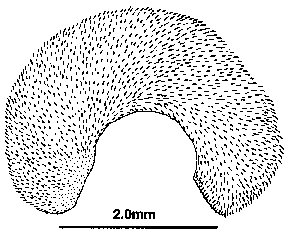
Type material. HOLOTYPE. AMS C.203646 (alcohol specimen, spicule
slide); length 5.4 mm, anterior, midbody, and posterior height 1.1 mm.
PARATYPE 1. AMS C.203647 (dissected alcohol specimen, radula slide, epidermal
and copulatory spicule slides); type locality. PARATYPE 2. AMS C.203648
(dissected alcohol specimen); type locality.
Type locality. Macquarie Island, from Garden Bay Peninsula,
vertical rock face, 11 m (Australia Museum Macquarie Is. Expedition 1977-78,
Stn MA-125, 16.xii.1977).
Diagnosis. Length to 6.5 mm; spicular coat rough, not shiny;
with dorsal carina; barbed spicules few; serrated spicules few, anterior
only; two deeply curved copulatory spicules per copulatory spicule sac,
the shorter one with grooves and ridges on distal half; cuticle thin (22
mm).
Description. Spicular coat rough; anterior and posterior ends
of body not tapered, flattened ventrally (Figs. 3E, 4B); with dorsal carina;
retracted mouth slit an inverted Y-shape, opening of mantle cavity axial,
short (Fig.4 A, C); body length to 6.5 mm, height even throughout, to 1.4
mm. Epidermis and cuticle thin, to 18 µm and 22 µm, respectively.
Epidermal spicules evenly curved, to 210 µm long by 14 µm wide
and more than 10 µm thick, bluntly pointed distally, base slightly
tapered with end rounded to straight (Fig. 5E); serrated spicules few,
from anterior body only, especially near mouth; few spicules with recurved
base; barbed spicules to 128 µm long by 9 µm wide, not numerous;
spicules from beside pedal groove nearly ovate but tapered and often curved
proximally (Fig. 5F). Radula (3 examined) with about 16 rows of teeth (Fig.
4D); tooth base about 75 by 18 µm, medial one-third attached to radular
membrane, number of denticles 7 to 9 excluding lateral fused denticles
(Fig. 4E, F); radula ending distally in two lateral pouches of pharynx.
Copulatory spicules (1 specimen examined) deeply curved, two per copulatory
spicule sac, 1.3 mm and 0.9 mm long, curve nearly 90° (Fig. 5D); longer
spicule simple, shorter spicule with ridges and processes on distal half.
Reproductive system. The reproductive system and copulatory
apparatus follows that of O. lituifera (Salvini-Plawen, 1978, figs.
95, 96) with these exceptions: (1) There are paired, large seminal vesicles
opening off the ducts leading from the gonads to the pericardium (gonopericardioducts).
(2) The paired copulatory glands, voluminous proximally and ending in narrow
tubes as in O. lituifera, open into the grooved and ridged distal
end of the ventral, smaller copulatory spicule shown in Fig. 5D and not
into a triangular tube formed by 3 small copulatory spicules as in O.
lituifera. (3) The copulatory spicules are deeply curved, not nearly
straight as illustrated for O. lituifera. (4) One pair of copulatory
spicules (the smaller?) opens into the mantle cavity on papillae (the sections
were too poor in this area to ascertain where the second pair of copulatory
spicules end)
